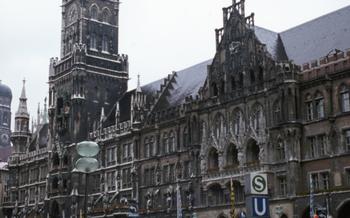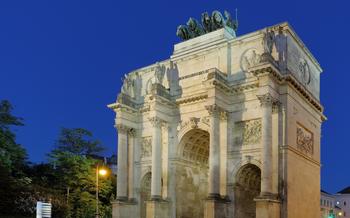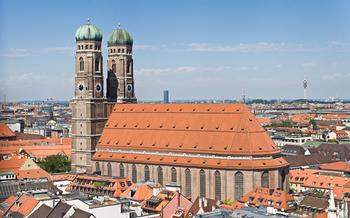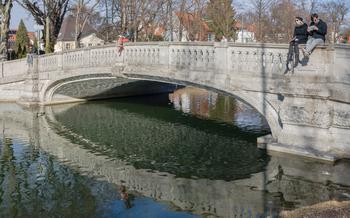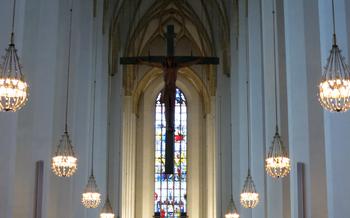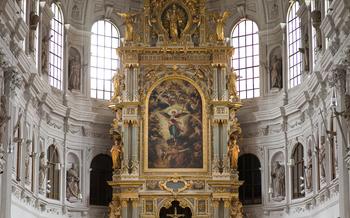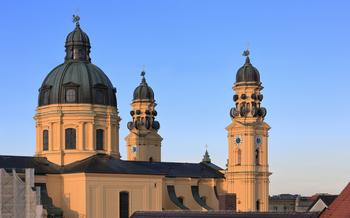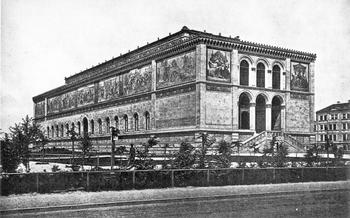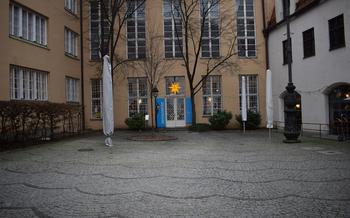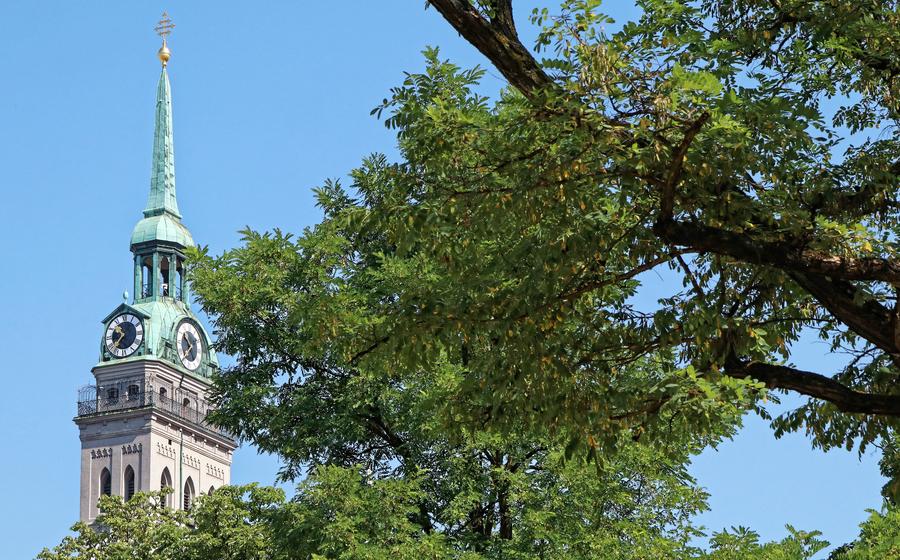
St. Peter's Church (Alter Peter)
- Location and Accessibility
- Exploring the Church Interior
- Ascent to the Tower
- Panoramic Views from the Tower
- St. Peter's Glockenspiel
- Historical Significance
- Legends and Folklore
- Cultural Significance
- Religious Importance
- Restoration and Preservation
- Nearby Attractions
- Insider Tip: Hidden Gem
Location and Accessibility
The awe-inspiring St. Peter's Church is conveniently located in the heart of Munich, at the intersection of Rindermarkt and Petersplatz. To reach this architectural masterpiece, you can take advantage of Munich's efficient public transportation system. Multiple tram lines, including the 19, 20, and 21, as well as the U-Bahn line U3 and U6, have stops within a short walking distance of the church. For those arriving by car, limited street parking is available in the surrounding area, but be prepared for potential restrictions and fees. If you prefer a more leisurely approach, consider exploring the city on foot. A scenic stroll through Munich's charming streets will lead you to this iconic landmark, allowing you to soak in the vibrant atmosphere and admire the city's architectural diversity.
Exploring the Church Interior
Step inside St. Peter's Church, and prepare to be captivated by its awe-inspiring interior. The church boasts a rich collection of religious artifacts, intricate sculptures, and stunning stained glass windows that narrate biblical stories and Munich's history.
As you enter, your gaze will be drawn to the magnificent high altar, a masterpiece of Baroque artistry. Its intricate carvings depict scenes from the life of St. Peter, the church's patron saint. Admire the delicate details and vibrant colors that bring the stories to life.
Take a moment to explore the side chapels, each dedicated to a different saint or purpose. The Chapel of the Holy Sepulchre, with its life-size figures depicting the crucifixion and resurrection of Christ, is a particularly poignant sight.
Don't miss the exquisite stained glass windows that adorn the church's interior. These colorful masterpieces depict biblical scenes and Munich's history, casting a warm, ethereal glow throughout the sanctuary.
St. Peter's Church is also home to several historical monuments and memorials. Look for the tomb of Emperor Ludwig the Bavarian, who played a pivotal role in shaping Munich's destiny. The church also houses memorials to fallen soldiers and victims of various tragedies, serving as a poignant reminder of the city's resilience.
Ascent to the Tower
The ascent to the tower of St. Peter's Church is an experience that offers breathtaking views of Munich and its surroundings. Standing at a height of 91 meters, the tower provides a unique perspective of the city's landmarks and the Bavarian Alps.
To reach the top, visitors can choose between climbing the 306 steps or taking the elevator. For those who prefer a more traditional experience, the climb up the winding staircase is a rewarding challenge, offering glimpses of the church's intricate architecture along the way. The staircase is well-lit and safe, ensuring a comfortable ascent for visitors.
For those with limited mobility or who prefer a more accessible option, the elevator provides a convenient and comfortable ride to the top. It operates during the church's opening hours, making it easy for visitors to enjoy the panoramic views without exerting themselves physically.
Safety measures are in place to ensure a secure ascent and descent. The staircase and elevator are regularly inspected and maintained to meet the highest safety standards. Handrails and safety barriers are installed along the staircase to prevent any accidents. Visitors are advised to wear comfortable shoes and clothing for the climb and to be mindful of their surroundings.
Panoramic Views from the Tower
Ascending the tower of St. Peter's Church is an unforgettable experience, offering visitors breathtaking vistas of Munich's cityscape. Standing at a height of 92 meters, the tower provides a panoramic view that encompasses the entire city and its surroundings.
From the observation deck, visitors can marvel at the intricate tapestry of streets, buildings, and landmarks that make up Munich's urban landscape. Notable attractions such as the Frauenkirche, the Deutsches Museum, and the Olympic Tower rise prominently, while the distant Alps form a majestic backdrop.
The panoramic views from the tower allow visitors to orient themselves within the city and gain a deeper appreciation for its geography. The Isar River meanders through the cityscape, while the Englischer Garten, Munich's sprawling urban park, forms a verdant oasis to the northeast.
Whether you're a seasoned traveler or a first-time visitor, the panoramic views from St. Peter's Church tower offer a unique perspective on Munich's beauty and grandeur. Don't miss the opportunity to experience this breathtaking vista for yourself and capture some unforgettable memories of your time in the Bavarian capital.
St. Peter's Glockenspiel
Within the confines of St. Peter's Church lies a treasure of artistic ingenuity and mechanical precision: the St. Peter's Glockenspiel. This elaborate clock tower, adorned with intricate carvings and colorful figurines, stands as a testament to Munich's rich cultural heritage and craftsmanship.
The glockenspiel, constructed in the 16th century, comprises 32 bells, each meticulously tuned to produce a harmonious melody. Every day, at 11 am, 12 pm, and 5 pm, the clock comes alive with a mesmerizing performance, captivating onlookers with its enchanting tunes.
The spectacle begins as the doors of the glockenspiel open, revealing a stage filled with moving figures. These mechanical marvels, representing historical characters and scenes from Bavarian folklore, dance and twirl to the rhythm of the bells, creating a vibrant and captivating display.
One of the most beloved figures is the Schäfflertanz, a traditional Bavarian dance performed by coopers. This joyful dance is said to bring good luck and ward off evil spirits, making it a cherished part of the glockenspiel's repertoire.
The St. Peter's Glockenspiel is not just a timepiece but a cultural icon, deeply embedded in the heart of Munich's identity. Its melodies have echoed through the city's streets for centuries, marking the passage of time and bringing joy to countless visitors.
Historical Significance
St. Peter's Church stands as a testament to Munich's rich and storied past. Its foundation in the 12th century marks a pivotal moment in the city's religious and cultural development. Throughout the centuries, the church has played a central role in shaping Munich's identity, serving as a spiritual center, a gathering place for the community, and a witness to countless historical events.
In the tumultuous years of the Reformation, St. Peter's remained a staunch bastion of Catholicism, resisting the wave of Protestant influence that swept across Germany. Its resilience during this period solidified its status as a symbol of religious fortitude and continuity.
During the Second World War, the church suffered extensive damage from Allied bombing raids. However, its sturdy structure and the devotion of the local community ensured its eventual restoration to its former glory. The scars of war, still visible on the church's exterior, serve as a poignant reminder of the city's resilience and its ability to rise from adversity.
St. Peter's Church has been a site of numerous religious and political gatherings throughout history. In 1662, it hosted the wedding of Ferdinand Maria, Elector of Bavaria, and Henriette Adelaide of Savoy, a lavish event that cemented the alliance between the two powerful families. In more recent times, the church has been the venue for state funerals and other official ceremonies, underscoring its importance as a symbol of civic pride and unity.
Through its enduring presence and historical significance, St. Peter's Church has become an integral part of Munich's identity. Its towers, visible from miles around, serve as a beacon of faith, resilience, and the city's rich cultural heritage.
Legends and Folklore
The allure of St. Peter's Church extends beyond its architectural grandeur and historical significance, as it is deeply entwined with the rich tapestry of Munich's legends and folklore. One captivating tale recounts the legend of the "Devil's Footprint," a mysterious imprint etched into a stone step leading to the church's tower. Legend has it that the devil himself, in a moment of frustration, left his mark on the stone after failing to strike a bargain with the church's builder.
Another popular legend speaks of the "Golden Rooster," a weather vane adorning the church's tower. According to the tale, the rooster was once stolen by a rival town, but the people of Munich were so distraught that they organized a daring raid to retrieve their beloved symbol. The rooster was successfully returned, and to this day, it proudly stands atop the church's tower, a symbol of Munich's resilience and determination.
These legends and stories, passed down through generations, have become an integral part of St. Peter's Church's identity. They add a touch of mystique and enchantment to this historic landmark, making it not just a place of worship and cultural significance but also a realm of captivating folklore and storytelling.
Cultural Significance
St. Peter's Church holds immense cultural significance in Munich, transcending its religious importance. It has served as a muse and inspiration for countless artists, writers, and musicians throughout history. Its distinctive silhouette and intricate details have been captured in paintings, sketches, and photographs, contributing to the city's rich artistic heritage.
The church's unique architectural features have also influenced the design and construction of other buildings in Munich, leaving a lasting legacy on the city's skyline. Its towering spires and intricate facade have become synonymous with Munich's architectural identity, making it a beloved landmark among locals and visitors alike.
Moreover, St. Peter's Church has played a vital role in shaping Munich's cultural traditions and festivals. The annual Peter and Paul Festival, held every June, attracts thousands of visitors who come to witness the colorful processions, lively markets, and traditional Bavarian music that fill the streets surrounding the church. These festivities showcase the deep cultural roots of the church and its enduring significance in the hearts of Munich's citizens.
Religious Importance
As a prominent Catholic church, St. Peter's holds a significant position in the religious landscape of Munich. Throughout history, it has served as a focal point for worship, pilgrimage, and spiritual guidance for the local community. The church's impressive architecture and sacred ambiance provide a serene setting for prayer, reflection, and religious ceremonies.
For centuries, St. Peter's has been a place of solace and devotion for Catholics in Munich. Its rich history is intertwined with religious events, traditions, and rituals that have shaped the city's spiritual identity. Pilgrims from near and far have flocked to the church to seek blessings, offer prayers, and venerate the relics of saints enshrined within its walls.
The church's interior is adorned with stunning religious artworks, sculptures, and stained glass windows that depict scenes from the Bible and the lives of saints. These artistic masterpieces not only enhance the church's beauty but also serve as a reminder of the profound faith and devotion of its congregation.
St. Peter's is also renowned for its role in fostering religious education and community outreach. It hosts a variety of programs, workshops, and events aimed at promoting spiritual growth, understanding, and inclusivity. Through these initiatives, the church actively engages with the local community, providing support, guidance, and a sense of belonging to its members.
Restoration and Preservation
St. Peter's Church has undergone several restoration and preservation efforts throughout its history, ensuring its architectural integrity and preserving its historical significance. One of the most extensive renovations took place in the 19th century, when the church's exterior was restored to its original Gothic style. During this time, the tower's spire was also rebuilt, adding to its iconic silhouette.
In the 20th century, the church suffered significant damage during World War II, with its roof and interior heavily affected. A meticulous restoration process followed, which aimed to restore the church to its former glory while maintaining its historical character. This involved repairing the damaged stained glass windows, restoring the intricate carvings, and rebuilding the destroyed altars.
Preserving St. Peter's Church is of utmost importance, as it represents a valuable cultural heritage not only for Munich but for Germany as a whole. The church's unique architectural features, historical significance, and religious importance make it a cherished landmark that requires ongoing care and attention.
Efforts to preserve and restore the church are ongoing, with experts continuously monitoring its condition and addressing any potential issues. This ensures that St. Peter's Church remains a vibrant and enduring symbol of Munich's rich history and cultural heritage for generations to come.
Nearby Attractions
After soaking in the grandeur of St. Peter's Church, take some time to explore the captivating surroundings. Just a stone's throw away, you'll find the Marienplatz, the heart of Munich, pulsating with life and energy. Admire the intricate facade of the Neues Rathaus (New Town Hall), marvel at the vibrant Glockenspiel performances, and soak in the lively atmosphere of this bustling square. For art enthusiasts, the Alte Pinakothek, Neue Pinakothek, and Pinakothek der Moderne offer a treasure trove of masterpieces from various eras. Immerse yourself in the world of renowned artists like Albrecht Dürer, Peter Paul Rubens, and Vincent van Gogh.
Stroll along the enchanting Hofbräuhaus am Platzl, one of the world's most famous beer halls, and savor the authentic Bavarian ambiance while indulging in a refreshing pint of beer and traditional delicacies. History buffs can delve into the city's rich past at the Deutsches Museum, a fascinating institution showcasing scientific and technological wonders. And for a touch of nature amidst the urban landscape, wander through the verdant expanse of the Englischer Garten, a sprawling park that offers tranquility and recreational opportunities.
Insider Tip: Hidden Gem
Venture beyond the main tourist routes to discover hidden gems within St. Peter's Church. One such treasure is the Reliquienkapelle, a small chapel tucked away behind the main altar. This intimate space houses a collection of sacred relics, including a fragment of the True Cross, a piece of the veil worn by the Virgin Mary, and a bone from St. Peter himself. The chapel exudes an atmosphere of tranquility and spirituality, offering a moment of reflection and contemplation amidst the grandeur of the church.
For photography enthusiasts, the tower's viewing platform presents a unique opportunity to capture stunning panoramic shots of Munich. Arrive early in the morning or late in the afternoon to take advantage of the golden light, which casts a warm glow over the city's rooftops and spires. Experiment with different angles and perspectives to create captivating compositions that showcase the church's grandeur against the backdrop of the cityscape.
